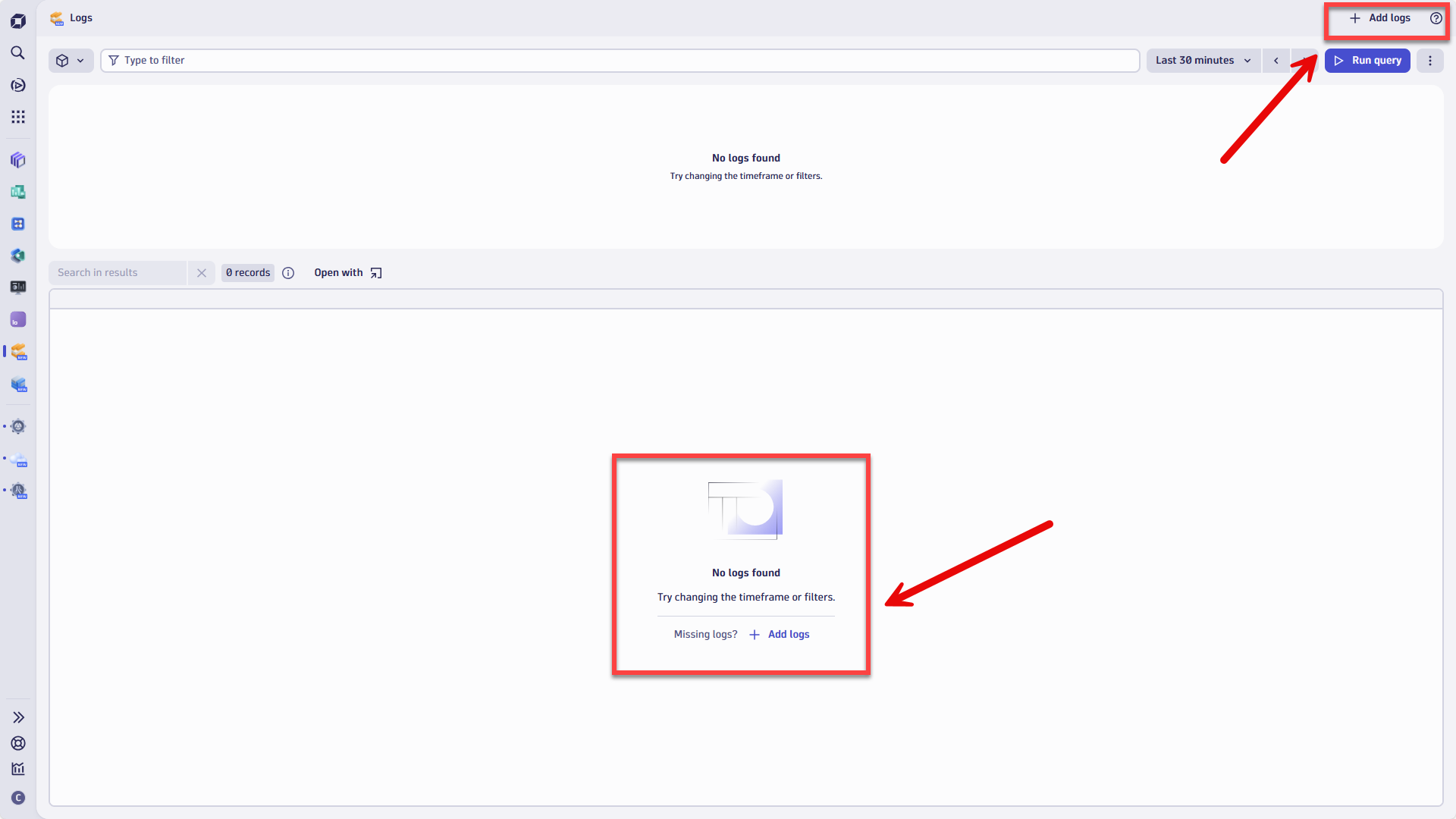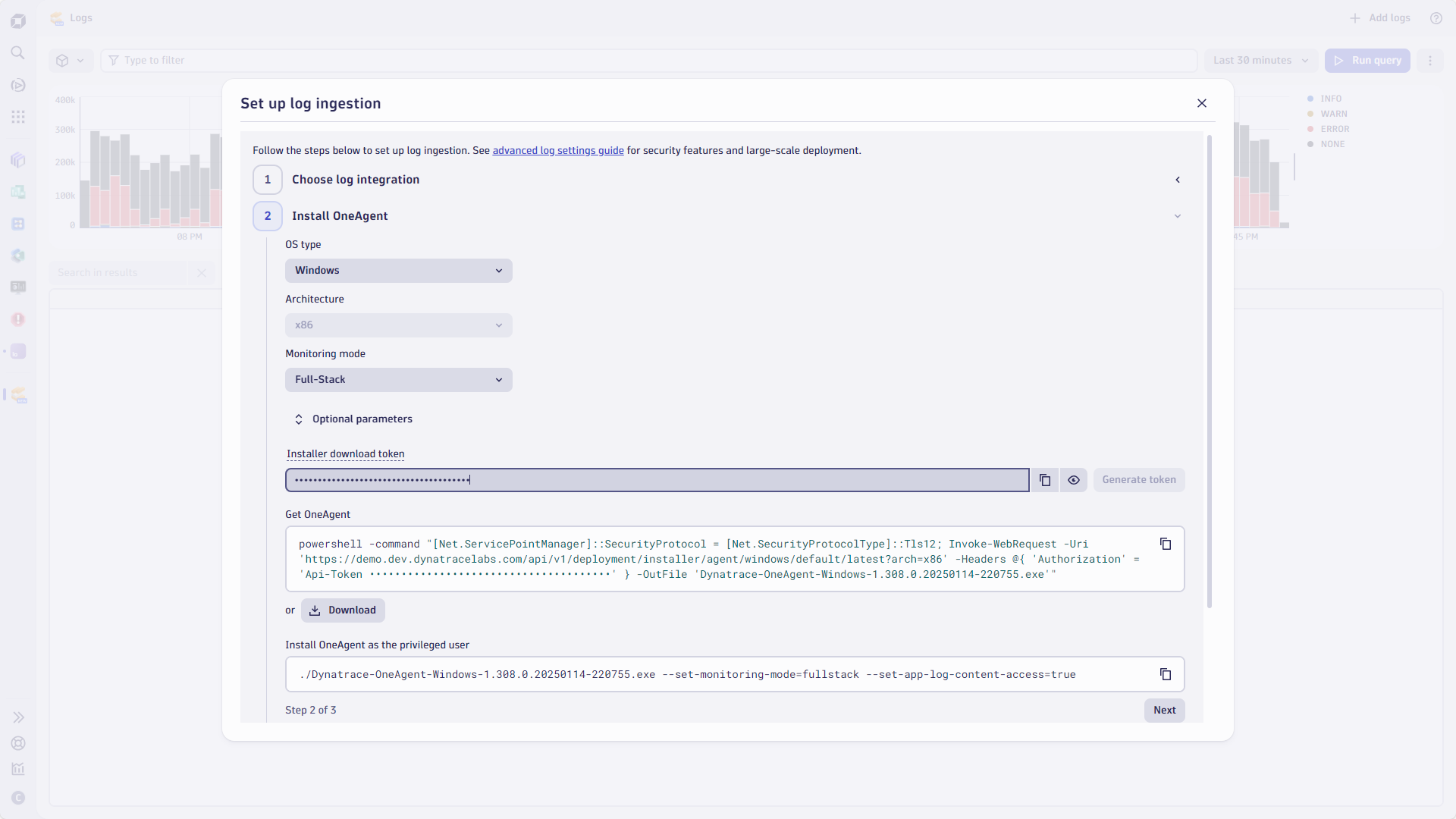Log ingestion can seem daunting when getting started with Dynatrace, especially when staring at an empty screen in the Logs or Clouds apps.
To address any concerns you and your new-to-Dynatrace teams may have regarding log ingestion, we’ve introduced a new and intuitive log onboarding wizard for Dynatrace® Apps.
The newly introduced step-by-step guidance streamlines the process, while quick data flow validation accelerates the onboarding experience even for power users.
This blog post explains how Dynatrace simplifies log ingestion, whether you’re onboarding logs from your infrastructure using OneAgent®, cloud services using log forwarding, or driving open-source standardization leveraging OpenTelemetry (OTel), Fluent Bit, or any other API-based ingestion methods.

Get started with Logs: The OneAgent advantage
For most scenarios, Dynatrace OneAgent is your best friend for getting started with Dynatrace log ingestion. OneAgent is flexible and dynamic, adapting to new requirements by configuring rule sets centrally within the Dynatrace platform.
A cornerstone of Dynatrace monitoring capabilities, OneAgent boosts your log ingestion experience by automatically detecting and tagging logs based on the detected process technology—even for custom-developed applications.

1. Step-by-step setup
The log ingestion wizard guides you through the prerequisites and provides ready-to-use command examples to start the installation process. This ensures that logs flow into Dynatrace within minutes.
This includes the creation of API access tokens, given the required permissions.
The pre-defined monitoring mode settings, for example, Full-Stack, are pre-selected following your platform administrator’s guidelines. Configuration is fully customizable.

2. Automatic log discovery
Once installed in an operating system or Kubernetes cluster host, OneAgent automatically detects logs from your deployment and ingests them into Dynatrace without requiring additional local configurations. During this process, OneAgent detects and links technologies, such as Java, Docker, or Microsoft IIS, for improved parsing and log analysis.
Tagging is also available when using API-based ingestion methods or later within the platform.
In any case, this ensures that your logs are immediately available for quicker filtering and grouping, and the readability of these log lines is improved.
After successfully installing OneAgent, the log ingestion wizard provides a host selector drop-down to validate the data flow.

3. Preconfigured log rules
Dynatrace provides a set of prepared log ingestion rules, so you don’t need to create custom configurations for common technologies and services. You can refine and modify these preconfigured rules to ingest relevant logs, mask sensitive data, and use advanced options—all configured centrally at scale.
While OneAgent automatically detects technologies and tags log lines accordingly, you can also manually configure OpenPipeline™ with processing rules for other log ingestion methods, such as OpenTelemetry (OTel), Fluent Bit, and any other API-based log ingestion method supported by Dynatrace OpenPipeline.

Hyperscalers and cloud platforms: Effortless log integration
Log ingestion is equally straightforward in cloud environments like AWS, Azure, and GCP.
The log ingestion wizard provides step-by-step instructions like you’ve just seen for OneAgent but also highlights the benefits of each integration, supporting you with additional resources to streamline your real-time log forwarding setup.

One of the main differences between OneAgent and public cloud platforms is that cloud platforms offer differing methods of log forwarding, streaming, and collection. Depending on your current setup and needs, you may want to choose one platform or another.

Following the instructions and recommendations ensures that your logs are available within a few minutes, just like with OneAgent, Otel, and other API-based ingestion methods.
Log forwarding and API-based ingestion: OpenTelemetry, Fluent Bit, and APIs
If you’re already using OpenTelemetry, Fluent Bit, or another log-forwarding solution, integrating with Dynatrace is effortless.
The API-based approach is the most flexible. It’s designed for users familiar with open source standardization looking for support for OpenTelemetry semantic, granular, and advanced log pipeline management capabilities paired with token-based API authentication.
In addition, the Dynatrace Log ingestion API supports additional use cases not covered by the aforementioned methods, such as Edge Computing, IoT, or Point-of-Sales (PoS) use cases.
With any or all of these methods simultaneously, you can build and customize your instrumentation precisely how you need it and benefit from Dynatrace enterprise-ready features without sacrificing open source principles. Using Dynatrace, you can maintain control and increase flexibility in your instrumentation choices.

Why log management is easier with Dynatrace
Dynatrace is the ideal enterprise-wide observability and security platform, as it supports your current and future cloud-native log ingestion methods.
The new log onboarding process is designed with simplicity, scalability, and user experience in mind—for novice users and experts. It provides the same accelerated experience regardless of whether you use OTel, OneAgent, or API-based ingestion.
The onboarding process allows you to create required access tokens, reuse existing tokens, and validate the data flow of selected entities, pipelines, and API tokens.
Start a free trial and experience the simplicity yourself!





Looking for answers?
Start a new discussion or ask for help in our Q&A forum.
Go to forum